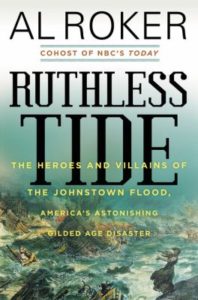 Ruthless Tide: Recalling the Johnstown Flood
Ruthless Tide: Recalling the Johnstown Flood
By Marcia Allen, Technical Services and Collections Manager
A couple years ago, Al Roker received significant praise for a book entitled The Storm of the Century. That memorable book recounted the worst natural disaster in American history, the 1900 hurricane that devastated Galveston, Texas, leaving some eight thousand dead and crushing buildings throughout the town. Reviewers particularly noted Mr. Roker’s careful retelling of historical detail, as well as the compelling stories of some of those caught by ravaging winds and high waves.
Now Roker has written yet another riveting tale of historical disaster. Ruthless Tide is an investigation into the 1889 flooding of Johnstown, Pennsylvania, a horrifying event that took the lives of over 2000 people and wiped out whole towns. This account, however, is not a natural disaster of the scope of the Galveston event. This time, Roker explains how man-made modifications triggered the tragedy.
Spreading across a low-lying valley, Johnstown was a steel-producing town. It was situated below an earthen dam along the South Fork of the Conemaugh River. At one time, there had been a large reservoir, but the dam was not maintained and eventually partially collapsed and began leaking water. The area behind the dam then became something of a wetland, useful only as grazing land.
But all of that changed in 1879 when some enterprising businessmen like Henry Fick and Andrew Carnegie decided to restore the dam, create a man-made lake behind it, and construct the South Fork Fishing and Hunting Club. Designed as a private resort for wealthy investors, the club boasted restaurants, available sailboats, even lakeside homes for its members.
Unbeknownst to most people, the old sluice gates which were designed to release water when the lake overfilled, were either removed or disabled. In addition, the dam was reinforced with clay to which stone was attached. Finally, a fishguard, made of iron rods suspended from the inner walls of the dam, prevented the cherished stock of black bass from escaping the lake. With the outlying buildings and amenities in place by 1881, the resort was fully operational.
The year 1889 brought freakish weather trends over the Memorial Day weekend. While the Johnstown residents were used to some flooding, the usual rains quickly developed into a 24-hour total of 11 inches. The already saturated ground could not handle the volume, and so city streets and basements accumulated water. The lake water above the town rapidly approached the top of the dam and the structure was soon compromised.
Why read this book? First of all, it is an example of how human intervention can bring about disaster. After the flood, a few of those most affected by its force instigated lawsuits to compensate for their losses, but the courts and lawyers hired by the shareholders of the club quashed those efforts. This led to a new age of liability, during which those who created the danger had to bear the responsibility of the damages.
A second appealing aspect of the book is in its exact details. We reader learn all about the early industrialists who built the steel empire. We discover the progression of errors that caused the dam to fail. We learn about the force behind a wall of water that easily upended train cars and leveled homes. We discover the flukes that can spare or destroy lives in a very short time period.
Perhaps the most appealing feature of the book is its attention to the stories of individual townspeople. The tale of little Gertrude Quinn is particularly poignant. Separated from her family during the confusing flight, the six-year-old became a legendary figure in Johnstown’s history. And the heroic efforts of some to save others is truly admirable. Thomas Magee, for example, managed not only to save his store’s cash, but also to work with other store employees, pulling people to safety and supplying food to those who were stranded.
In all, this is a finely crafted book, with compelling human drama and a solid historical telling. You will not regret this reading experience.

